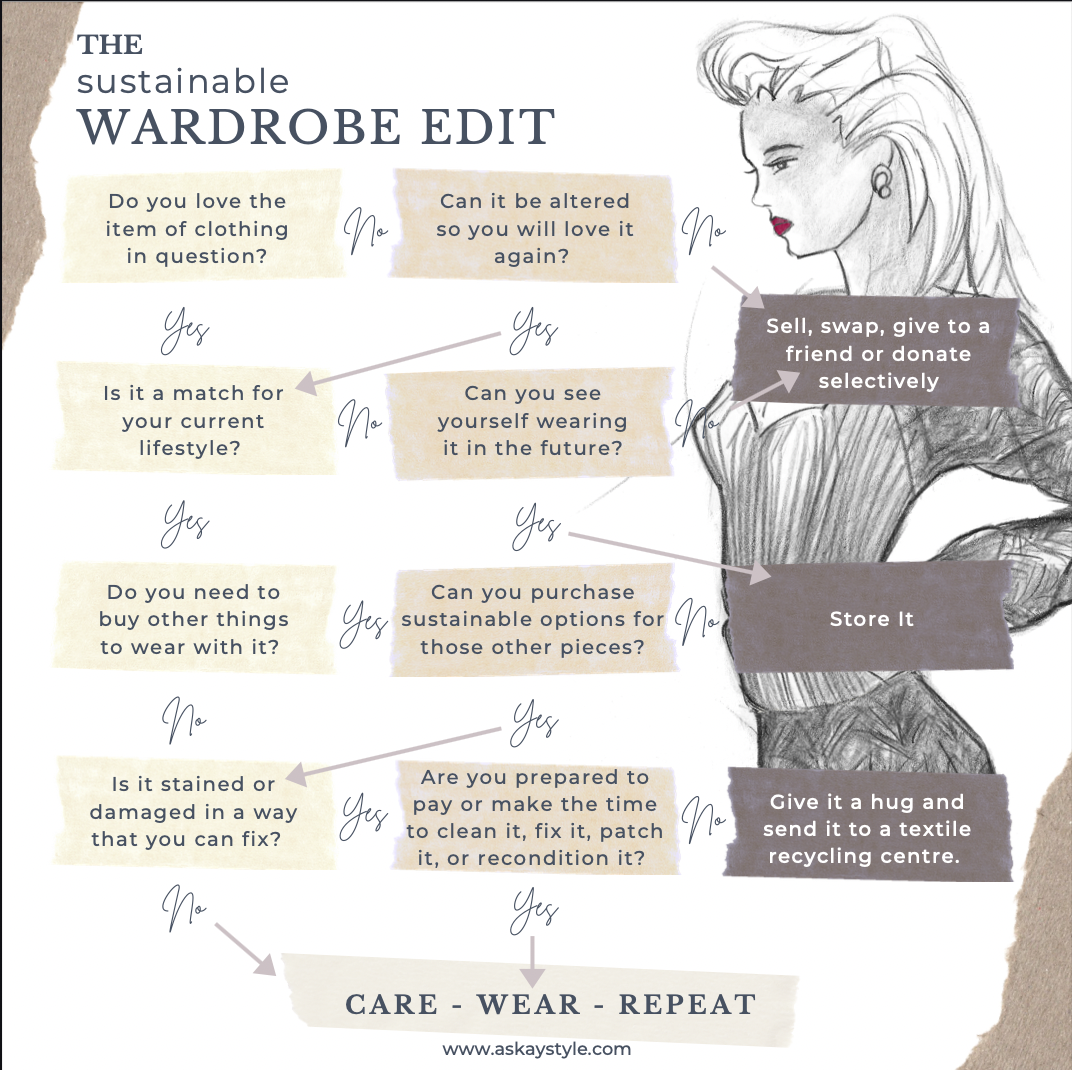Lighter evenings and an end in sight to lockdown restrictions make it feel like we’re finally emerging from the longest winter and bouncing back out into the sunshine again.
A whole new wardrobe of clothes to parade around in the big world sounds refreshing—but let’s not sell out on our sustainable principles and order a stack of new clothes.
How about hosting a personal sustainable wardrobe edit party for yourself instead?
When was your last really good edit? Maybe the last time you moved house? Perhaps it was when you became so frustrated because you couldn’t get another hanger squeezed onto the rail. Are you already doubling up, or are there three or more things on one hanger? Kids have left home and you’ve taken over another wardrobe in a different room? Sound familiar?
Clearing out our closet is a chore many of us put off until we absolutely have to do it.
I’ve been there. I used to have a small wardrobe where I would have at least three things on each hanger.
When I moved and bought hangers for each of my items to hang in their own space, I was completely taken aback by how many clothes I actually had. However, I wasn’t inspired to wear what I had—in fact, it became the opposite.
The old cliché of a “wardrobe full of clothes but still got nothing to wear“ was my reality. I was overwhelmed and confused—until I organised and edited my clothes.
Afterward, my go-to favourite clothes were on show like found in a boutique. I still love opening my wardrobe and seeing them there, inviting me to pull them on and feel fabulous—versus the previous frustration of not knowing where to start.
However, how we tackle editing our wardrobes needs to have a significant shift from what is currently the norm. Simply clearing out what we haven’t worn recently and donating it to charity is not a sustainable solution. The theory of “if you haven’t worn it for a season, it’s time to get rid of it” is a broken mentality. That must have been written by a fast fashion marketing machine. As much as I like Marie Kondo for her storing, folding, and organisation tips, her approach to editing clothes doesn’t address sustainability issues.
So here is my 2021 method and reasoning for how to sustainably edit your wardrobe:
>> Ask: can I alter this?
When asking ourselves if it can be altered to adjust to a new size, check to see if seams can be opened to utilise any seam allowance. If not, can a contrast fabric be added in as a new design detail to give a dress an extra inch or two where needed? Does something simply need to be shortened for you to love it, or do you need to add a fun trim to the bottom hem to make it a little longer? Can you make two old skirts into one new skirt you will enjoy wearing? Can you cut the skirt off a dated dress and have a lovely new top to wear?
>> Get creative.
There are a multitude of ways you can be creative with what we already have:
Pinterest is the place to start for a fix of inspiration. This one page of ideas alone makes me wish I had a denim jacket, just so I could get creative with it.
>> Donate.
When we give or throw something away, we have to become aware of where this mythical place actually is. There is no such place as Away. We need to be responsible for our own waste. In Orsola de Castro’s book, Loved Clothes Last, she writes:
“New Yorkers throw 200,000,000 lbs of clothing into the trash every year. That’s the equivalent of 440 Statues of Liberty.”
When we do buy something, it is no longer about the now. We need to engage our consciousness.
How was this garment produced in the first instance and what we will do with this garment when we no longer have a need for it?
Charity shops are overflowing with donations. Seventy percent of clothes that are donated are sold in bulk to textile sorting companies. Many of the clothing items received by charities today are of such poor quality they have no second-hand value. Developing countries are rightfully closing their doors to our Western world’s unwanted waste. Their streets are full of unsaleable abandoned clothes mountains, which slowly rot for generations. Some of these clothes mountains are burnt but by doing so they are releasing noxious fumes into areas already contaminated by high levels of air pollution.
If items end up in the category of “Sell, swap, give to a friend, or donate selectively,” What does donating selectively mean?
>> Research.
Look for companies who are taking back specific items of clothes—like this current campaign being run by Kit Change who are accepting donations of old sports kit. Give directly to a local homeless shelter or to a charity focussed on keeping clothes in use locally.
>> Store.
I can’t emphasize enough, how much we can gain from removing items out of our wardrobe that we can’t see ourselves wearing this season and storing them elsewhere. It makes finding what we do want to wear easier, we can see them clearly and in one edit you look like you’ve adopted the coolest collection of cherished clothes!
If you have duplicates or clothes that are very similar, put away the duplicate and save it for the future.
Buy specific garment storage boxes or use a suitcase—just make sure they are freshly laundered as marks and stains have a nasty habit of appearing on stored clothes. Make a list of what’s in there and then pop it out of sight but not out of mind. If you don’t unzip it for a few years, it doesn’t matter. If you loved them when you stored them, you will find a way to wear them again in the future. That’s exactly how many of my favourite pieces in my wardrobe are now over twenty years old. You can obtain that new clothes feeling all over again when reinventing how to wear them.
>> Repurpose.
If an item is stained or damaged and it just can’t be repaired into something you will wear, can you reinvent it as a cushion cover? Napkins? Washable kitchen paper replacement? Bunting? A fabric bag? Washable face wipes? When we recycle our old clothing into something that reduces the need to buy something new, that’s a win for the planet and your pocket.
The scraps left after we have altered, salvaged, and reused all that we can, still have a small value and can fulfill a future role as packing or insulation – reducing the need for virgin materials to be used. Bag and label these remnants as rags then pop them into a Salvation Army bin or take/ship them to your local textile recycling centre. They can go directly for shredding to make packaging or insulation.
Saving clothes from landfills and making sure we stay in love with what we already have is the most sustainable fashion option.
Follow these principles to achieve that blissful, inspiring, wardrobe of clothes—that is also sustainable.
~

~










Read 6 comments and reply